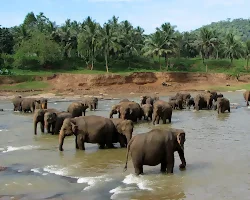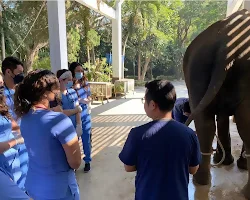
It is a world-renowned sanctuary for rescued and orphaned elephants. This remarkable facility has a rich history and has played a vital role in elephant conservation and rehabilitation since its establishment in 1975. The orphanage has not only become a popular tourist destination but also a symbol of hope for the protection of them and the preservation of their natural habitats. In this essay, we will explore the origins of the Pinnawala Elephant Orphanage, its significance in elephant conservation, the daily routines of the elephants, challenges faced, and its impact on the local community and international visitors.
It was established in 1975 by the Sri Lankan Department of Wildlife Conservation. Its primary purpose was to provide care and rehabilitation for orphaned and injured elephants found in the wild, with the ultimate goal of releasing them back into their natural habitats whenever possible. The sanctuary is situated in the village of Pinnawala, approximately 90 kilometers northeast of the capital city, Colombo, and covers an expansive area of lush greenery, ponds, and open spaces.

Prior to the establishment of the orphanage, Sri Lanka faced significant challenges in protecting its elephant population due to human-elephant conflicts, habitat loss, and poaching. Many baby elephants were left stranded and helpless when their parents were killed or driven away from their natural habitats. The orphanage aimed to address this issue by providing a safe and nurturing environment for these innocent creatures.
It has been instrumental in the conservation of Sri Lanka’s elephants. The sanctuary operates as a captive breeding center, where they are encouraged to mate and produce offspring in a semi-natural environment. This approach helps maintain genetic diversity and contributes to the long-term survival of the species.
Furthermore, the orphanage has successfully hand-reared numerous elephant calves over the years. These calves receive round-the-clock care, as they would have in the wild, from a dedicated team of mahouts (elephant keepers) and veterinarians. The mahouts act as surrogate parents, providing emotional support and nourishment to the young elephants.
Once the orphaned elephants mature and gain sufficient independence, the staff at the orphanage begin the process of reintegrating them into the wild. This process, known as “soft release,” involves gradually acclimating the elephants to the wilderness while still providing them with some support and supervision. Soft release helps the elephants adapt to their natural environment, learn survival skills, and eventually join wild herds.
It offers a unique experience for visitors from all over the world. Every day, visitors are treated to a spectacle of watching the elephants engage in various activities. One of the most popular attractions is the elephants’ bath time, which takes place in the nearby Ma Oya River. The sight of these gentle giants frolicking in the water and playfully interacting with each other is a sight to behold.
Apart from bathing, visitors can observe the feeding sessions, where the elephants are provided with a balanced diet of fruits, vegetables, and specially formulated elephant feed. These feeding sessions also serve as educational opportunities for visitors to learn about elephant nutrition and behavior.

Additionally, visitors can witness the elephants’ daily walk, where the herd is guided from the orphanage to the river and back. This walk not only provides exercise for the elephants but also allows them to graze on the lush vegetation along the way.
While it has been successful in its conservation efforts, it also faces several challenges. One of the main concerns is the issue of captive elephant management. Critics argue that keeping elephants in captivity, even under the guise of conservation, is not an ideal solution. They believe that captive elephants should eventually be released into the wild, whenever possible, to ensure the long-term survival and well-being of the species.
Furthermore, there have been concerns about the carrying capacity of the sanctuary. As the number of elephants in captivity increases, there is a need to ensure that the orphanage’s facilities and resources can adequately accommodate their needs.
It has had a significant impact on the local community and the country’s tourism industry. The sanctuary has created employment opportunities for local residents, with many working as mahouts, caretakers, and support staff. Additionally, the influx of tourists has stimulated the local economy, as visitors often purchase handicrafts, souvenirs, and other products from nearby shops.
However, the growing popularity of the orphanage has also raised concerns about the potential negative effects of mass tourism. The increased footfall of visitors could disturb the elephants’ daily routines and cause stress to the animals. As a result, there have been calls for sustainable tourism practices that prioritize the well-being of the elephants and the environment.
The Pinnawala Elephant Orphanage stands as a symbol of hope and dedication in the conservation of elephants in Sri Lanka. It has served as a safe haven for countless orphaned and injured elephants, providing them with care, rehabilitation, and a chance at a better life. The sanctuary’s efforts have contributed to the preservation of the country’s natural heritage and have raised awareness about the importance of elephant conservation worldwide. While there are challenges and concerns to address, the Pinnawala Elephant Orphanage continues to inspire and educate visitors, local communities, and conservationists in the ongoing fight to protect these magnificent creatures and their natural habitats

OURA Travel operates with the utmost dedication to offering exceptional experiences. While we endeavor to ensure accurate and enjoyable tours, our services are subject to availability and may change without prior notice. We bear no liability for unforeseen circumstances, injuries, or loss during the tours. Booking confirmation is contingent upon availability and adherence to our specific booking conditions, including terms and cancellation policies. Participants are advised to meet health requirements for travel, as we disclaim liability for issues arising from health or fitness limitations. Additionally, our descriptions are aimed at accuracy, although errors may occur, and we reserve the right to rectify any information or pricing inaccuracies.